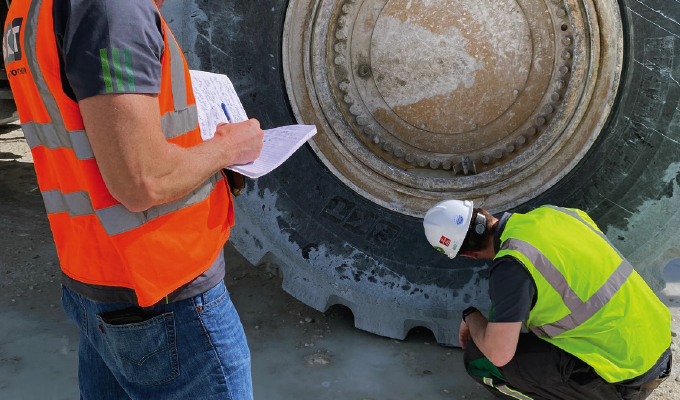Maintaining tire safety on jobsites is not an easy task. The massive size and weight of some of the equipment and the tires can create very complex issues. Plus, the environments they are used in, like earthmoving, construction, and mining, can present many potential hazards. One mistake can lead to serious injury or even death, so safety is key.
Proper procedures and OSHA rules should always be followed on jobsites. Regular and consistent training is very important when it comes to checking and servicing OTR tires. Tires and equipment have limits as to how much weight they can handle, how fast they can run, how much impact they can absorb, and how much heat they can withstand. Being educated on these limits helps prevent accidents and damages on the worksite.
TRAINING FOR BEST CARE
It is important for companies and contractors to provide continuous training to their employees on the safety and care of tires and equipment. Abuse and misapplication are some of the leading causes of accidents and failures on the jobsite. This leads to downtime which then leads to an increase in operating costs.
Before beginning a job, be sure to regularly inspect the tires and machinery for any damages. For tires, check for any imbedded objects, chunks of torn rubber, tread detachment, uneven wear, or exposed steel or belts. Cracks, punctures, or severe wear on the tires could lead to blowouts which can cause serious damage. Inspect the bead area for any damage or detachment as well.
Wheels should also be checked for things like loose lug nuts, damaged valve stems, cracks, and irregular wear. Never use any form of heat on a wheel assembly as this can lead to pyrolysis, a high heat chemical reaction that creates a deadly blowout. This can happen even hours after the heat source has been removed.
TIRE AIR PRESSURE
Managing tire air pressure is one of the most important practices for a safe and efficient operation. It is crucial to have tires inflated to the proper pressures to handle the weights of the loads they will be lifting or moving. Tire Pressure Monitoring Systems (TPMS) are safety systems that allow operators to keep constant watch on air pressures so that any issues can be caught and corrected before any major problems arise. These tools can help lead to increased production on the jobsite.
BKT’S TECH STAFF
BKT has an experienced technical staff that can visit work sites to train staff and inspect tires to help ensure a safe operation. BKT has even developed a tire tracking system that monitors tire performance by gathering data from the jobsites, vehicle, and loads to identify key issues and determine the best tires and practices to increase performance. SPOTech (Satellite Performance Optimization Technology) gathers operational data and helps troubleshoot issues such as belt separations, heat issues, tire cuts and punctures, and irregular wear.
CLOSING THOUGHT
Following proper safety guidelines, performing regular maintenance, and keeping up with training are the best ways to prevent OTR tire failures and worksite injuries. Ensuring a safe work environment will prevent incidents which can lead to downtime and a decrease in revenue.
For More Information:
To schedule a visit with a BKT technical specialist or to learn more about BKT tires, visit www.bkt-tires.com.
Modern Contractor Solutions, March 2022
Did you enjoy this article?
Subscribe to the FREE Digital Edition of Modern Contractor Solutions magazine.



